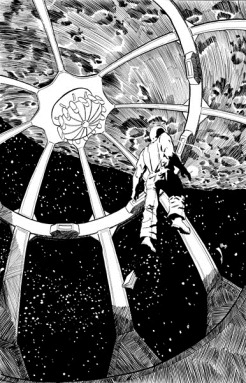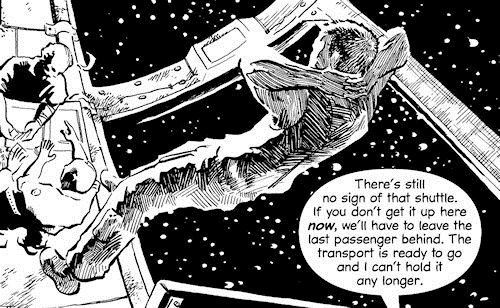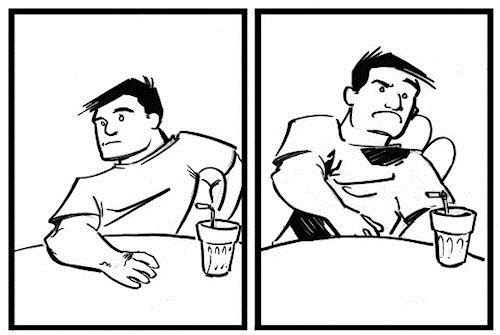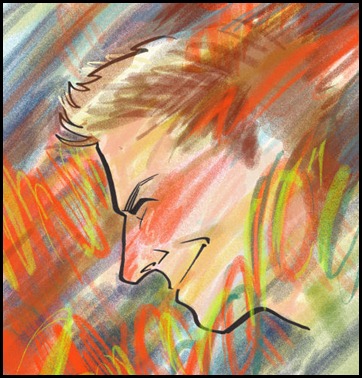How to Make Web Comics for One Solid Year
For one year, I’ve written, drawn, lettered, and regularly posted my webcomic, BorderCrash. Here is what I learned.
1. Planning a Comic Workflow Pays Off
This is how I want to draw BorderCrash:
But this is how I actually draw BorderCrash:
I know how hard I work. It’s reasonably hard. Kind of hard. Certainly not chained-to-the-drawing-board, uber-nerdy, masochistically hard. And there’s no way I can draw a ten-hour page once a week. So I developed this simple, less moody style, on purpose. I was pretty sure I could draw a five-hour page once a week. And so far, that’s been mostly right. I planned my workflow around how hard I work.
I’m also not disciplined enough to tell myself “It’s eight o’clock! Time to work on BorderCrash!” And to get around that little problem, I carry this strip around with me almost all the time. It’s in the same bag with my glasses, phone charger, and Kindle. That way it gets pushed forward in the little moments of free time we all come across, like waiting for your number at the DMV, killing half an hour before your appointment, or stakeouts. BorderCrash is drawn at 8.5” x 11.25”, which is way smaller than most comics, and smaller than I’d like. The only reason it’s so small is that it fits in my backpack. I have a clipboard/container that holds several pages of BorderCrash, scratch paper for writing and thumbnails, ruler, panel templates, pencil, eraser, and the three or four pens that I ink with. The script, supplies, and a drawing board are always with me. I planned my workflow around little, unplanned moments of free time.
2. The “Web” Part of “Webcomics” is Important
 Years ago, I looked into webcomics a little bit. HTML stopped me cold. A friend was making comics using WordPress with the ComicPress plugin, just like this strip is right now. “It’s easy!” He told me.
Years ago, I looked into webcomics a little bit. HTML stopped me cold. A friend was making comics using WordPress with the ComicPress plugin, just like this strip is right now. “It’s easy!” He told me.
It is not easy. I didn’t know anything about HTML and how the internet worked. WordPress is great in that it rewards basic web knowledge with huge versatility, but you need that basic web knowledge. I gave up for a while.
In 2010, I learned HTML for a job. It took a week. It’s a simple language, with only 10-20 commands you really need to remember. I got regular practice for a year or so, on my and others’ websites. In 2011, I tackled webcomics again with a little more dedication and a lot more know-how. And this time, it was easy.
Several sites will host your webcomic without you needing to know a thing beyond scanning and hitting the “upload” button. But you’ll lose out on a lot of ownership if you do that. Just take the week to learn basic HTML, then buy a site from a host that offers a one-click WordPress install, like Bluehost or iPage. It’ll save you some trouble down the road.
3. I Don’t Care Who Reads This Webcomic
 After a couple of years focusing on internet marketing and SEO, this one really surprised me. How could I be happy with almost no readership and traffic? How was I ever going to make money with this strip? Why was I even doing it if almost no one was reading it?
After a couple of years focusing on internet marketing and SEO, this one really surprised me. How could I be happy with almost no readership and traffic? How was I ever going to make money with this strip? Why was I even doing it if almost no one was reading it?
If you have any WordPress experience, you’ll notice I haven’t made a single modification to this site in over a year. After the first week of setting up structure and content, the template hasn’t been modified, no titles have been streamlined, and the fonts are pretty much stock. Black and white it came, and black and white it remained. I don’t care. I love making comics.
The ridiculous drive to make comics has been with me since I was 14. There is always a project in the works. I grew up and the desire was still there, and I moved and moved and moved and the desire was still there, and I got married and the desire was still there, and now I’m having a baby and the desire is still there. If I’m not making comics, I feel wrong.
Webcomics are just about perfect for me. An updating schedule that I set and abide by. A story I control. A free framework to experiment in. A few readers to keep me honest. A growing body of consistent work I can be proud of. These are the things I care about.
So while thousands of nerdy fans, truckloads of money, and fame in the subculture would be nice… I find the most joy out of just making this comic.
4. Lettering
I really didn’t know how to letter at all when BorderCrash began. Didn’t know how to drag the handles around a vector word balloon to reshape it. Didn’t know where to get a font. Didn’t remember the name of the font after a month of use, so the letters changed completely right in the middle of the story.
Now I know kind of how to letter. I also know that it’s boring. If this strip ever makes money, step one is to get someone else to do it!
5. Consistency Takes Time
I’m not even there yet. I’m still making small changes to the drawing style every week. On the one hand, it bothers me that so much of BorderCrash looks bad. On the other hand, Opus the Penguin began his life with a small nose, Garfield was a weird blob, and Daisy Mae was a flat-chested waif. I figure by the 10,000th time I draw Ted, his hair will be looking the same in each panel.
So that’s what I learned last year (that I remember in this moment). I’m still excited about the story, still getting a handle on all the skills needed, still plugging away. Getting better at finishing things. You know, I think finishing projects may be the most valuable skill an artist can have.
And there’s my second blog post in a year!
Thanks,
-Tielman


